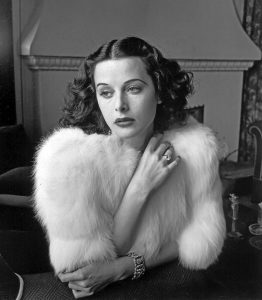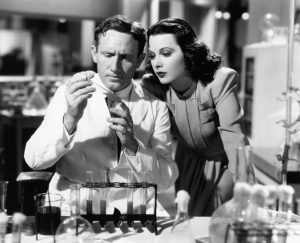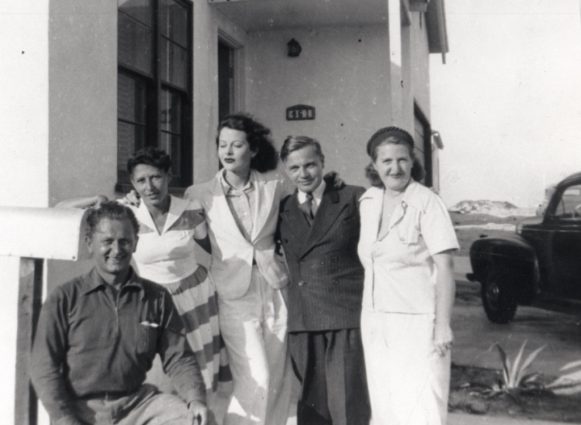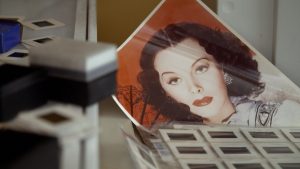This story features “Bombshell: The Hedy Lamarr Story” presented by Bender JCC of Greater Washington. Learn more about this film screening and get tix.
Although she had brains as well as beauty and sex appeal, the life of screen star Hedy Lamarr zig-zagged between delight and despair. And often the brains part was overlooked.
Or else it was until British filmmaker Alexandra Dean wrote, directed and co-produced “Bombshell: The Hedy Lamarr Story,” a documentary that focuses on the actress’s side career as a noted inventor.

The film has been making the rounds of multiple film festivals since it came out a year ago, drawing more attention than the director had expected. One reason is the enduring fascination with Lamarr, but the idea of a strong woman as smart as she was beautiful has special resonance today.
Now the film is coming to the Bender Jewish Community Center in Rockville for one screening only, as part of the JCC’s Cinema-J, a monthly series featuring films through a Jewish lens.
The Austrian-born sexpot, called Hedwig Kiesler until movie mogul Louis G. Mayer gave her a contract with MGM and suggested a name change, dazzled film audiences during the 1930s and ’40s. Billed by the studio as “the world’s most-beautiful woman,” she starred with the likes of Spencer Tracy, Clark Gable and Jimmy Stewart and appeared in such films as “Samson and Delilah,” “White Cargo” and “Algiers.” The actress also was said to be the model for Snow White and the inspiration for Cat Woman.
Although her looks were considered more impressive than her acting, Lamarr was hard to forget on screen or off. Hers was a colorful life — starting with “Ecstasy,” the sexually explicit (for the time) film she made while still in Austria, in which an adolescent Lamarr swam and ran through the countryside nude. The resulting scandal may have motivated her parents to marry her off to an older munitions dealer, who, though Jewish, had fascist connections, according to Dean. Lamarr later ran away from him.

Not being forgotten isn’t the same as being well-known. The documentary has surprises unrelated to the inventing as well. She was Jewish, but her children claimed they never knew her religious identity until after her death. Yet, she was very sensitive to what was happening to Europe’s Jews. “Hitler amputated a part of her life, so we can’t judge, but understand,” said Dean. “Maybe not telling made her feel safer.”
Although Lamarr resented the emphasis on her looks, she was so insecure about losing them in old age that she underwent several plastic surgeries that only made things worse. But, Dean commented, the press taunted her mercilessly when her beauty diminished, “so perhaps, again, we can understand.”
Lamarr married and divorced six times, and her boyfriends included Howard Hughes. But the aspect of her life least known to the public and most intriguing to Dean was the inventing. “Being an inventor for Lamarr was not only an eventual reincarnation but serious stuff,” the director said. “While she was making films, she would come home and work on inventions.”

The work wasn’t idle, either. In 1941, working with composer George Antheil, she co-devised a frequency-hopping technology for secretly guiding torpedoes to their target. The U.S. Navy initially rejected the invention, only to use it years later. By that time, the patent the two inventors held had expired.
Still, their invention paved the way for the spread spectrum communications technology underpinning Bluetooth, GPS and Wi-Fi. Lamarr was inducted into the National Inventors Hall of Fame posthumously, in 2014. In 1997, when she was 84, she received the American Electronic Frontier Foundation’s Pioneer Award.
The actress and composer had much in common, having both left school in their teens and lacking formal training in science. “But they did have beautiful minds,” Dean said.

Lamarr’s interest in inventing developed when she was very young, taking apart things and putting them back together. According to Dean, her film career was secondary to the “sideline.”
“Bombshell” uses a great deal of stock footage, but Dean tracked down cassette tapes of a telephone interview Lamarr gave to Forbes magazine journalist Fleming Meeks in 1990, when she was 76 and reclusive.
The JCC has a composite film festival, but, said Frieda Enoch, director of COA services, “We had asked ourselves, what would bring people out of their homes on a weekday night? And a good answer seemed to be a film series of one film a month.”
Cinema-J aims to include feature films, both provocative and funny, documentaries, indies, and Israeli films,” she added. “People enjoy seeing films in a nice center and getting together to socialize, as well.” Cinema-J is particularly geared for adults and baby boomers.
Enoch personally learned from “Bombshell,” not having known previously, for example, that Lamarr “had a Jewish side to her.”
What did Dean learn from researching Lamarr, in addition to her complexity? “She did grow from her extraordinary life,” the director said. “A poem she read to her children stated that you may never get applause and recognition for what you’ve done, but when you look back, you can say that you tried to change the world. And that was the meaning of life.

“That moved me, especially at a time, with social media, and such, that we are so self-absorbed,” Dean said.
Making “Bombshell,” she added, was about acknowledging as a culture how little power we give to older women, and to try to fight back. “So much value is placed on how we look. Lamarr was dismissed when she said she was an inventor. People were blinded by her beauty. We begin to see that beauty is not a sustainable source of power and respect.”
She hopes those who have doubts about Lamarr’s inventive genius will be convinced by “Bombshell.” Enoch agreed: “‘Bombshell’ seemed like a timely piece, recognizing that behind their appearance and the superficial, women are powerful.”
“Bombshell: The Hedy Lamarr Story,” plays at 7:30 p.m. Wednesday, May 2, in the Kreeger Auditorium of the Bender JCC of Greater Washington, 6125 Montrose Road, Rockville. Next in Cinema-J is “The Last Laugh,” pairing clips from films, performances and interviews with top comedians and prominent Jewish leaders. The last film in this season’s series, it will be shown at 7:30 p.m. Wednesday, June 6. For general information, visit www.benderjccgw.org or call 301-881-0100. Tickets are $10. For information about Cinema-J, contact Frieda Enoch at 301-348-3809 or fenoch@benderjccgw.org.